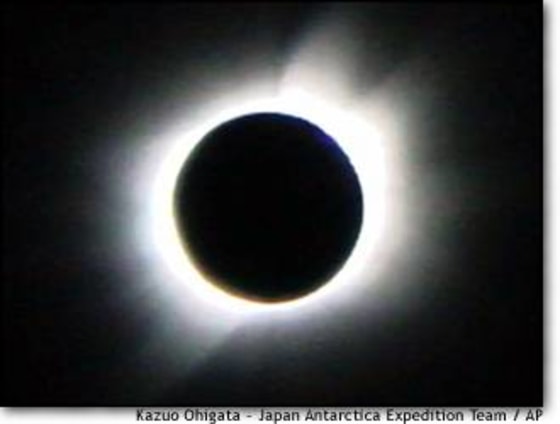Hundreds of scientists and staff in Antarctica braved freezing temperatures Monday to catch a glimpse of the first total solar eclipse ever recorded on the icy continent.
As the Sun was blotted out, scientists at the U.S.-run McMurdo Station, which spends much of the year in the total darkness of the Antarctic winter, watched in awe.
“The surface (of the sun) that’s being eclipsed is absolutely black compared to the brightness of the sun,” Liz Sutter told The Associated Press in a telephone interview as she watched the partial eclipse through medical X-ray glasses to protect her eyes.
“I can notice it getting a little dimmer — it’s definitely not dark, but dimmer,” she said. “It’s so cool,” she added as the eclipse reached its height.
The moon began shading the face of the sun at 11:08 a.m. (5:08 p.m. ET Sunday) at New Zealand’s Scott Base and the nearby U.S. McMurdo Station on the northern Antarctic Coast, New Zealander Natalie Cadenhead said.
A short time later, Sutter said staff and scientists at McMurdo were out viewing the “pretty exciting” event, with “an absolutely clear view of it.”
Conditions at both bases were partially overcast, with the outside temperature at 19 degrees Fahrenheit (-7 degrees Celsius), said Sutter, administration coordinator for U.S. Antarctic support company Raytheon Polar Services, based in Boulder, Colo.
Cadenhead, Antarctica New Zealand’s information officer, said staff at Scott Base used welding masks to shield camera lenses to capture the eclipse on film.
She said they had had good views of the partial eclipse in spite of the partial cloud cover above the base.
There was “no appreciable difference in light levels” during much of the eclipse, Cadenhead said.
Astronomer Brian Carter from New Zealand’s Carter Observatory said a long narrow swath of Antarctica would have experienced a total eclipse, but it was likely to have been seen by very few human eyes on the sparsely populated continent.
He calculated that an arc up to 440 miles (700 kilometers) wide and 3,200 miles (5,000 kilometers) long, partway between New Zealand and South Africa, had had a total eclipse.
“Quite a lot of Antarctica got a total eclipse ... because the sun was so low” in the sky, Carter said.
Partial eclipses also occurred over parts of Australia, as well as over southern New Zealand and South America.
The locals in Antarctica took the event in their stride.
“The fur seals don’t mind what’s happening around them,” Cadenhead said. “They just snooze on the ice” as usual.
